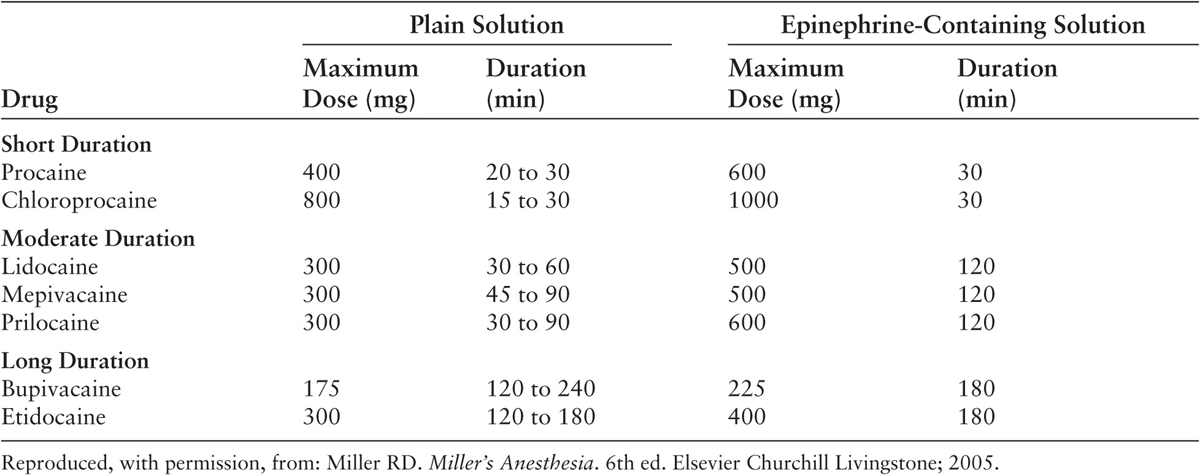Chapter 11. Local Anesthesia
Stephen L. Ratcliff, MD; Fred E. Shapiro, DO
INDICATIONS
Local anesthesia can be used as the sole anesthetic or as an adjunct to general or monitored anesthesia for multiple aesthetic head and neck procedures. Common methods of administration include local infiltration, topical application, and regional nerve blockade. Each route affords different benefits to the patient, but all are intended to reduce anesthetic requirements, postoperative opioid use and its associated side effects, and time to discharge in the recovery area. Additional benefits include having a patient maintain spontaneous ventilation with a patent airway, facilitation of tissue undermining, reduction of bleeding when a concurrent vasoconstrictor is used, and reduction in costs associated with the procedure.
Local anesthetics are not without their concerns. When given in excessive amounts, plasma concentrations can reach toxic levels and lead to a progression from simple numbness of the tongue or lightheadedness, to convulsions and coma, and, ultimately, to respiratory arrest and cardiovascular depression.
PREOPERATIVE PREPARATION
There are two main considerations to keep in mind when preparing for a procedure in which large amounts of local anesthetics will be given. Of utmost importance is the ability of the healthcare provider to respond to an emergency should one arise. In addition to having intravenous access, this entails having all the necessary resuscitation equipment immediately available, including an oxygen delivery system, resuscitation drugs, suction apparatus, monitoring equipment, and personnel (see Chapter 13 for full list of necessary equipment). The second consideration is to avoid high plasma concentrations that can lead to drug toxicity.
WHAT IS THE SAFEST DOSE OF LOCAL ANESTHETIC?
Recent advances in the use of local anesthetic solutions in surgery has led to much controversy regarding the absolute safe-dose limit of local anesthetic. Total dose, rate of administration, dilution, vascularity of the area injected, and coadministration of a vasoconstrictor can all affect blood levels. However, even though manufacturers publish maximum recommended doses, it is still difficult to predict blood levels from the dose that is given in the clinical setting.
When epinephrine is contained in a lidocaine solution, the published recommended doses do not exceed 7 mg/kg or a maximum of 500 mg. Plasma levels of lidocaine between 5 and 10 mcg/mL can lead to hypotension by cardiac suppression and vascular smooth muscle relaxation, and in concentrations greater than 20 to 30 mcg/mL cardiopulmonary arrest may occur. Recent studies have challenged these recommendations. A good example in practice is tumescent liposuction, whereby lidocaine doses in the range of 35 to 55 mg/kg have been used safely. Ramon et al found that for facelift surgery dilute lidocaine with epinephrine can be given at doses 3.1 times higher than the recommended dose with a plasma concentration 72% below the level that would lead to signs of toxicity. Although these studies show that greater doses of lidocaine than recommended have been given safely to patients without achieving toxic blood levels, there still remain reported incidents of toxicity with higher doses. This warrants further evaluation with larger prospective studies.
LOCAL ANESTHETICS: VARIOUS TYPES AND CHOICES
Although all local anesthetics can lead to local and systemic toxicity if given in excessive amounts, a more desirable goal is to avoid toxicity by judicious selection of the appropriate drug and by paying attention to concentration and volume used (Table 11-1). Commonly used drugs for ambulatory anesthesia include lidocaine, bupivacaine, ropivacaine, and levobupivacaine.
Table 11-1 Local Anesthetics Used for Infiltration Anesthesia

The benefit of lidocaine is its short duration of action and rapid onset. Bupivacaine is employed when a longer duration of action is desired, but care should be taken with this medication as it has a smaller therapeutic window. The main concern with bupivacaine is potential cardiac (bradycardia, arrhythmias, and/or cardiac arrest) and central nervous system (nervousness, seizures, respiratory depression) effects that are associated with unintentional intravascular injection. Concern for cardiotoxicity led to the development of ropivacaine and levobupivacaine, both of which are structurally similar to bupivacaine, but which have a greater safety profile.
ADJUVANTS
Adjuvants are commonly added to the local anesthetic to either prolong the anesthetic effect or to speed the onset of the drug. A vasoconstrictor such as epinephrine is frequently added to reduce peak blood levels by delaying absorption and subsequently prolonging the anesthetic’s duration. A good example, which is described below, is tumescent local anesthesia solution.
To speed the onset of the local anesthetic, 8.4% sodium bicarbonate can be added just before injection. Bicarbonate (makes the pH more alkaline), when added, affects the onset of lidocaine and mepivacaine more than it affects the onset of bupivacaine. The suggested dose is 1 mL of bicarbonate added for each 10 mL of lidocaine or mepivacaine; with larger doses, precipitation may occur within the solution.
PROCEDURES
Liposuction
In 2008, liposuction was the second-leading surgical cosmetic procedure in the United States. There are 2 similar techniques of liposuction, superwet and tumescent, that involve infiltrating the surgical area with a mixture of normal saline or lactated Ringer solution with lidocaine. Common lidocaine concentrations range from 0.025% to 0.5% and contain epinephrine, usually in a dilution of 1:200,000 to 1:1,000,000. In the context of aesthetic head and neck surgery, if closed (cervicofacial) liposuction is performed, local anesthesia and monitored sedation may be adequate. Infraorbital, mental, and cervical plexus nerve blocks are often used to supplement this technique. If liposuction is performed with another aesthetic procedure, such as rhytidectomy, general anesthesia with a laryngeal mask or endotracheal tube may be preferred by the surgeon. In all instances, close communication should be maintained among the healthcare team so as to avoid local anesthetic toxicity, particularly when more than one provider may be administering local anesthetic through various regional and infiltrative techniques.
Stay updated, free articles. Join our Telegram channel

Full access? Get Clinical Tree








